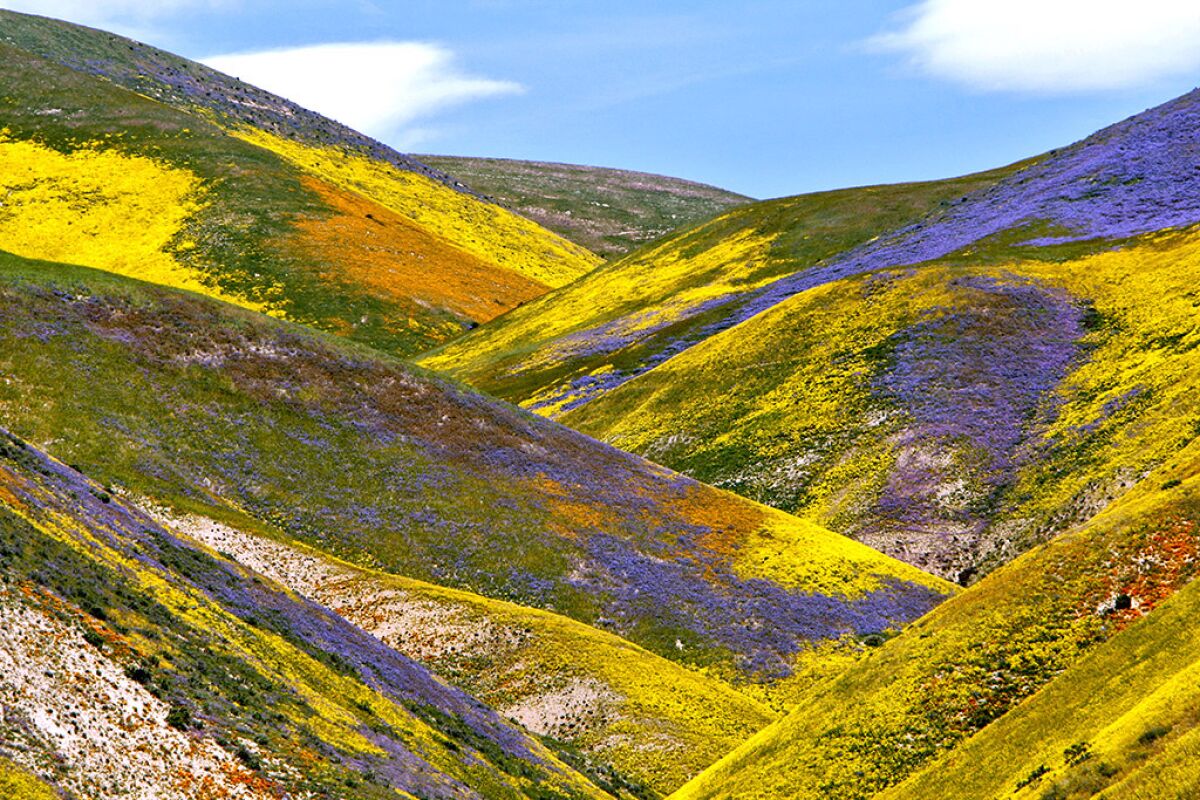

Hey! PSA: It’s okay to be excited about a superbloom. As Angelenos, when you start to hear the word “superbloom” circulating, it’s typically accompanied by a groan. The rising popularity of bloom-seeking in recent years has stirred up controversy around environmental etiquette, as explorers wreaked havoc on the sensitive flowers, some (most) in effort to take the perfect picture for social media. Some towns have even banned visitors altogether after previous damages. While this ban is certainly understandable, so too is human enamorment with the extraordinary natural phenomenon. There’s a reason people flock to these inspiring meadows and canyons, and it’s absolutely possible (and encouraged!) to experience California’s springtime wildflowers popping off in a safe and responsible way.

The term “superbloom” was coined in the 1990s, and while there’s not an exact metric to what makes (or doesn’t make) a superbloom, the label basically signifies an above-average growth. And there’s a bit more nuance to what will produce a superbloom than just a large amount of rain. For instance, a winter with many short storms may have different effects than one with fewer lengthy deluges, like this year’s atmospheric rivers that poured a year’s worth of rain on California in just a few short weeks (or what Angelenos would consider the longest weeks of all time). Cool temperatures at night may better regulate seed germination compared to early season heat waves which may jump start the growing process prematurely. So it remains to be seen whether 2023’s springtime meadows will be as dramatic as those in 2019 – which were seen from space – but it seems promising so far!
CALIFORNIA’S PARTY DRESS
The thing is: California’s superblooms have been exciting to us well beyond the last five years. In 1929, a National Geographic writer painted a vivid picture that “in early spring, California dons her party dress.” The first people to appreciate California’s springtime bounty, of course, were the indigenous communities, who have long celebrated the hoards of desert lilies, tarweed, and sunflowers. A rainy winter season meant both a beautiful landscape and a plentiful harvest of edible leaves, petals and seeds. It was common for indigenous tribes to burn the fields of flowers after collecting their edibles, encouraging regrowth.
Spanish colonist Juan Bautista de Anza described the coastal prairies and canyon meadows between Southern California and the Bay Area in the late 1700s as “verdant as they are flower-covered.” Early Los Angeles residents took trams to Pasadena and Altadena to frolic in the wild poppies. Over time, agriculture and invasive plants took their toll on California’s natural flower fields. Now, most fields are restricted to National Parks where they can be protected.
FOLLOW THE YELLOW SEED ROAD
One of the most prominent superbloom flowers painting the California hillsides gold these days is wild mustard. Despite its prominence, it’s technically not a native Californian! So how did this invasive wildflower get here? There are a few theories. One legend is that mustard – native to Spain and other Mediterranean countries – arrived in California via the adobe bricks used to build the Spanish missions. Others suggest the Franciscan padres planted bright yellow mustard as “markers” for the Camino Real, a road that connected the Spanish missions. Similar to this theory, another story is that the flower helped ship captains get their bearings when approaching or traveling along the shore. Some say the Spanish “conquistadors” simply planted mustard in their gardens as a seasoning herb intentionally, and the seeds spread from there. Due to the lack of written documentation, it’s hard to verify which of these theories are accurate; all we know for sure is that wild mustard was introduced to California in the late 1700s and remains as one of most popular superbloom personalities (it has some “main character energy” if you know what we mean).
As you could imagine, there are mixed feelings about mustard. Invasive species will always upset the balance of an ecosystem, and that’s not great. However, they can also bring unexpected assets. With wild mustard, for instance, vineyards in Sonoma appreciate the plant’s bio-fumigants, which help suppress vine-damaging nematodes. Back in the day, the wild mustard plant provided nutrients to both the Spanish colonizers and indigenous communities, who ate its leaves raw in salads and made spicy pastes from its seeds, respectively.
SUPER-YUM
Here at Eat Your Flowers, we’re into popping petals. So let’s get into what superbloom flowers are edible! Here are three edible botanicals you can harvest this spring in California:
- Wild Radish
- Wild Mustard
- California Poppy*
*Be mindful that it’s prohibited to pick California Poppies on state lands, but you may harvest the flowers on private land with permission.

Wild mustard leaf is hot and tangy, and can bring a nice spice to salads when used raw. Loria tops her carrot orange aura soup with mustard flowers – along with yogurt and olive oil – to add a nice zing to the dish. Similarly, wild radish carries a strong power, and works well as a topping or pickled with complementary ingredients like bay leaves and pink peppercorns. The beautifully bright poppy flower can be used in baked goods, salads, steeped in teas. The California Poppy is not nearly as strong as the Opium Poppy, and it won’t put you to sleep like Dorothy (it’s not lost on us that this is the second Wizard of Oz reference in this blog post), but it should still be ingested with caution for first-timers. Everyone’s digestive system is different, so take it slow. Medicinally, the California Poppy has the potential to help with sleep, anxiety, and pain relief without the addictive or disorienting effects of Opium.
AN ANGELENO’S GUIDE TO BLOOM-SPOTTING
If you’re a Los Angeles local (or visitor), we thought we’d offer a few of our favorite places to gaze at California's springtime canvas – without trekking out to the populated Joshua Tree:
- Point Dume – bordered by white sand beaches and the royal blue Pacific Ocean, a superbloom at Point Dume is certainly a sight for sore eyes. Accessible right off the PCH in Malibu, there’s a quick 0.3 mile trail from a parking area to the top of the point with 100 feet of elevation change.
- Corral Canyon – also in Malibu, a slightly longer route called the Corral Canyon loop invites ample opportunity for flower-viewing, at 2.4 miles roundtrip and an elevation gain of just-over 500 feet.
- Zuma Ridge – longer still is the Zuma Ridge Trail, at 5.6 miles out and back and a nice gain of 1,473 feet in elevation. While more challenging, this trail through the Santa Monica mountains offers incredible views of the famous California Poppy!
- Harmon Canyon Preserve – farther north in Ventura is newly established Harmon Canyon Preserve, a protected area set back from the coast with miles of walking trails among wildflowers.
- Malibu Creek State Park – also offering miles of hiking trails is Malibu Creek SP. Be mindful of potential trail closures due to rainfall this year; but hey, the good news is the creek will actually be full and lively, setting a beautiful backdrop to the fields of flowers.
- Upper Las Virgenes Canyon Open Space Preserve - shoutout to the valley! With more than 5,600 acres of hillsides, this preserve offers incredible vistas of the superbloom and plenty of space to spread out. There’s an easily accessible parking lot at the Victory trailhead that only runs you $3.
FLOW-ETHICS
We’ve heard it all before but we’ll say it again: be kind to our dear native wildflowers. They’re a bit fussy. Stay on trail (you and your little dog too!) and try to seek out destinations off the (literally) beaten path. Did you know there’s a wildflower hotline?! And no, this is not to report flower crimes. It’s an informational, pre-recorded line that provides updates and facts about the flowers you might see on your trip.

That’s all, flower friends! Enjoy the blooms this year – whether or not they are deemed “super” – and take care of Mother Nature. She’s the best.
